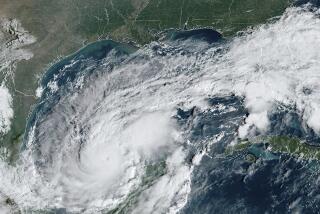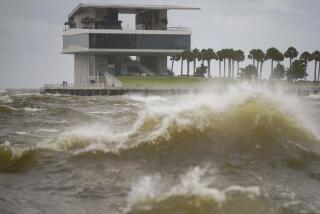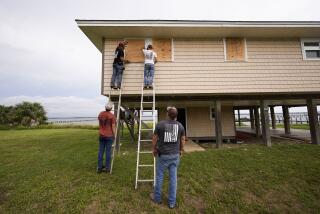Huge Winter Storm Threatens East With Hurricane-Force Winds, Snow
An enormous storm developed Friday in the Gulf of Mexico and took aim at much of eastern North America, weather officials said. It threatened to cause blizzard conditions from Georgia to Canada Maritimes, batter vulnerable coastline areas with hurricane-force winds and flooding, and freeze crops in the South.
“This could be the worst storm of the century,” the National Weather Service in Philadelphia reported in one of a series of blizzard warnings posted from North Carolina to Maine, including Washington, Baltimore, New York and Boston.
“We’re not crying wolf this time. It’s really coming,” said Brenda Page, a weather service meteorologist in Huntsville, Ala.
Snow began accumulating in northern Alabama and spread as far north as Virginia by Friday night. High winds drove water over a seawall along Louisiana’s Lake Pontchartrain, forcing closure of a highway. Sustained winds of 62 m.p.h. with gusts to 80 m.p.h.--74 m.p.h. is hurricane force--were recorded in the Gulf.
In southern Florida, authorities moved 60 people from a tent city erected in Naranja for victims of last year’s Hurricane Andrew to a high school as a precaution. A tornado watch was issued Friday night for all of Florida except the extreme northwestern region.
In northern New York, homeless shelters had filled up by mid-afternoon. Up and down the East Coast people stocked up on groceries, batteries, gas and other supplies.
Terry Collins said customers were emptying his Super Fresh food store in Westminster, Md., of bread and milk. “Of course I think they have a good reason to be scared this time,” he said.
Forecasters said snow accumulations in the hardest-hit areas could be measured in feet instead of inches. Blizzard conditions include sustained winds of at least 35 m.p.h., heavy snow and visibility near zero.
The storm was gathering on the anniversary of one of the worst storms on record in the East, the blizzard of 1888, which dumped up to five feet of snow on March 12-13 of that year.
The weather service said hurricane-force winds, waves to 25 feet and tides as much as six feet above normal would cause major flooding and severe beach erosion along the Atlantic Coast from the Carolinas north. Gales and seas to 18 feet were forecast down to northern Florida and along the Gulf Coast.
The mid-Atlantic and Northeast coastline was especially susceptible because many dunes were flattened and barrier beach islands were breached by a powerful storm in December and severe gales since.
The weather service office in New York City put the storm’s size in perspective: By the time snow was expected to start there, around dawn today, the storm’s center would still be over Georgia, some 700 miles away.
Air and road travel was expected to be snarled throughout much of the East and South during the weekend.
The storm’s main ingredients were arctic air from Canada mixing with the subtropical water of the Gulf of Mexico in a deepening low pressure system over the western Gulf. It was moving east at 50 m.p.h. and was expected to cross the Florida Panhandle and barrel up the Eastern Seaboard before pushing into Canada on Sunday.
The Federal Emergency Management Agency, the American Red Cross and many state and local agencies activated emergency plans, including the Emergency Broadcast System. Officials were considering evacuations of coastal areas.
Blizzard-like conditions were forecast to dump as much as a foot of snow in the mountains of Alabama and Georgia, and up to 10 inches in southeast Kentucky and eastern Tennessee. Light snow also fell Friday in Texas, Louisiana, Arkansas, Tennessee, Mississippi and Georgia.
Forecasters warned of a hard freeze as far south as northern Florida and south-central Texas, with the wind-chill factor expected to dip to near zero overnight in the coldest weather of the winter. The weather service warned farmers to take steps to protect plants.
More to Read
Sign up for Essential California
The most important California stories and recommendations in your inbox every morning.
You may occasionally receive promotional content from the Los Angeles Times.










